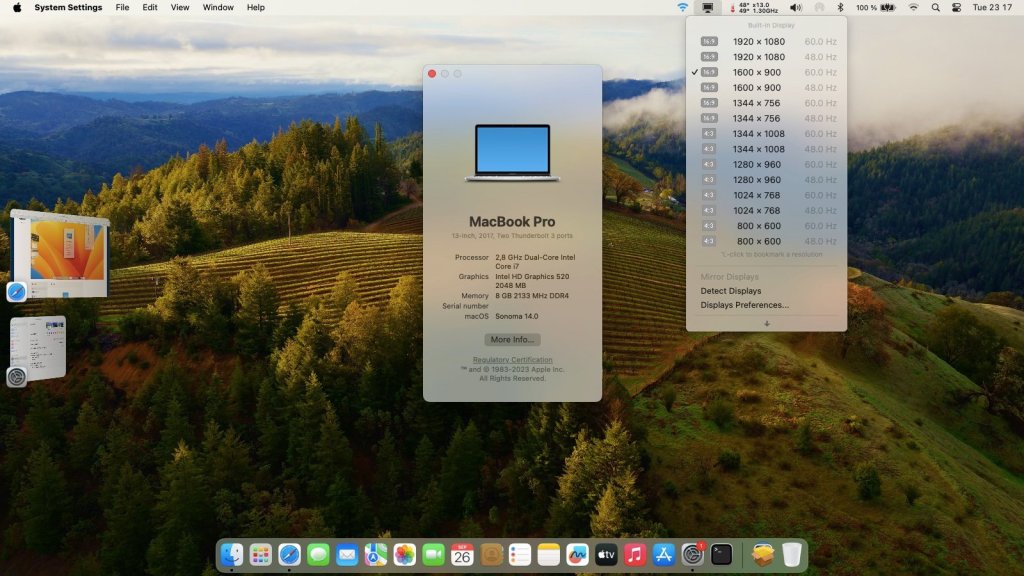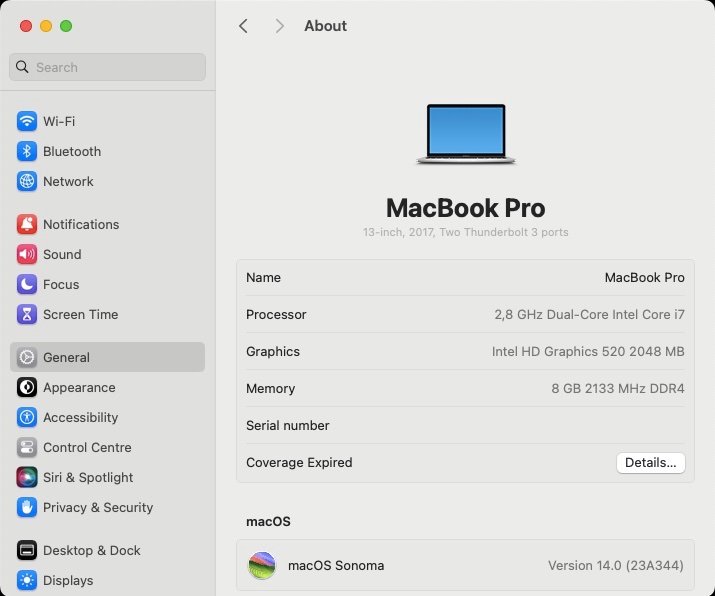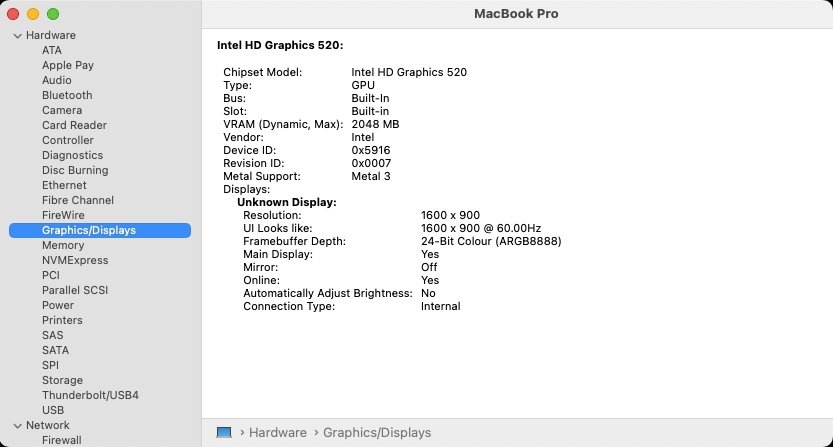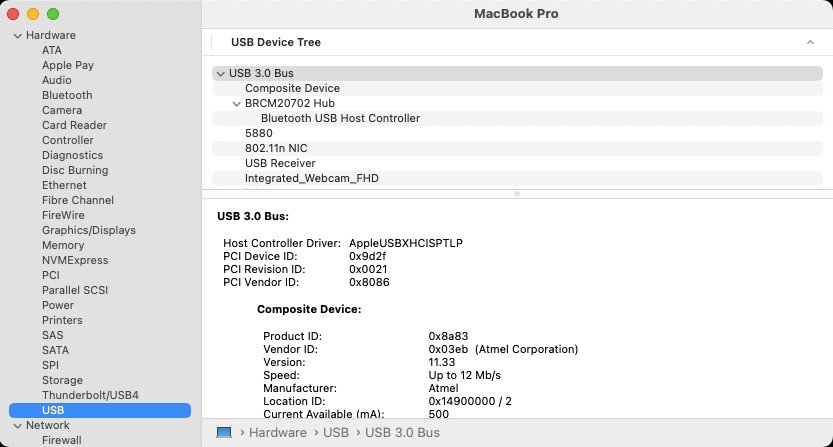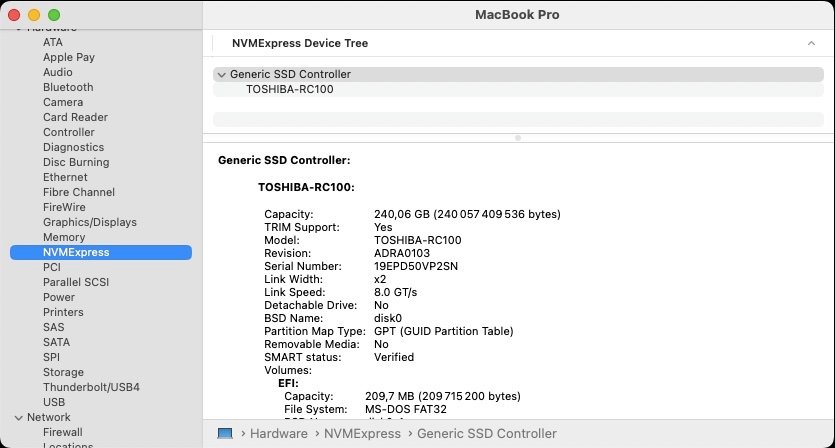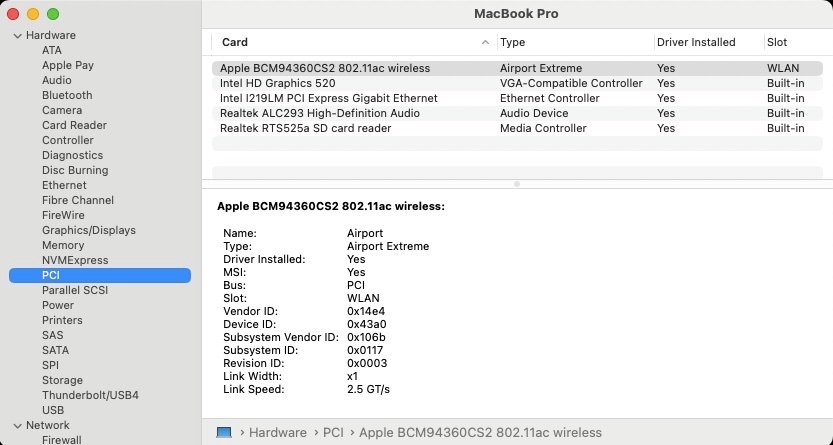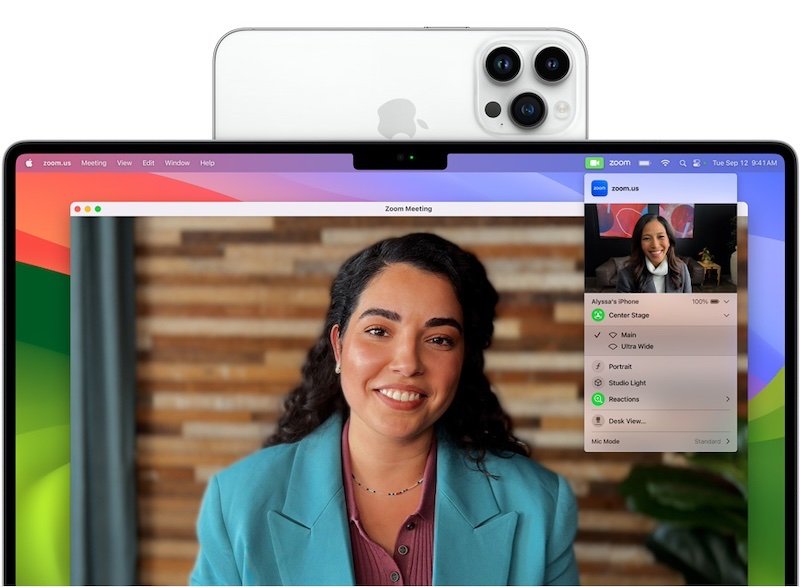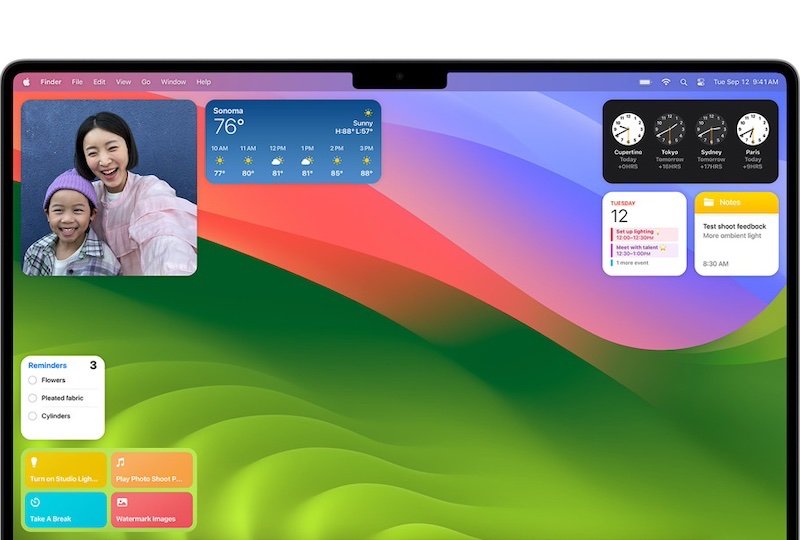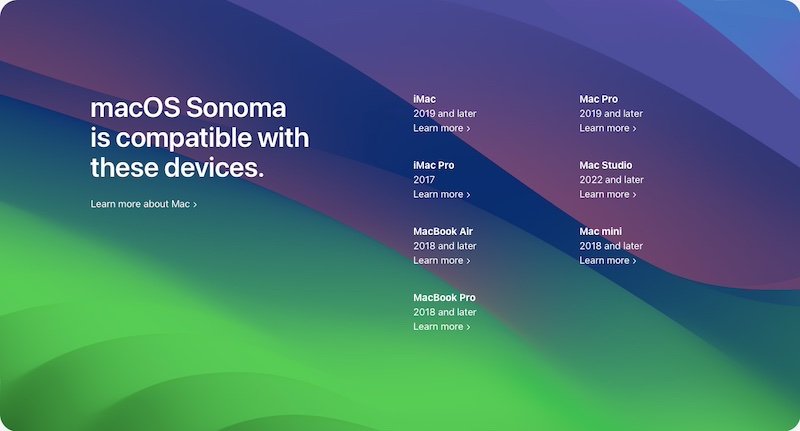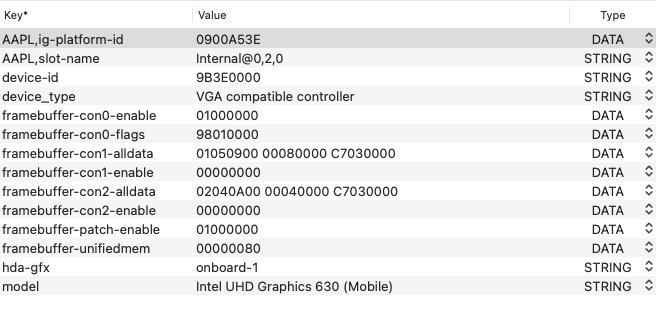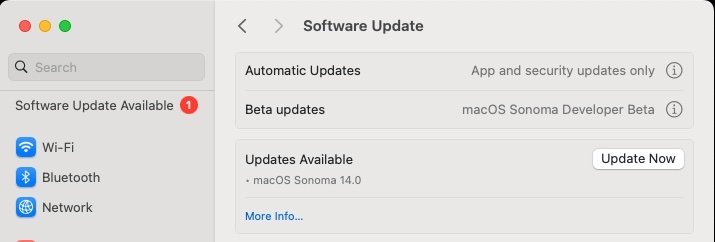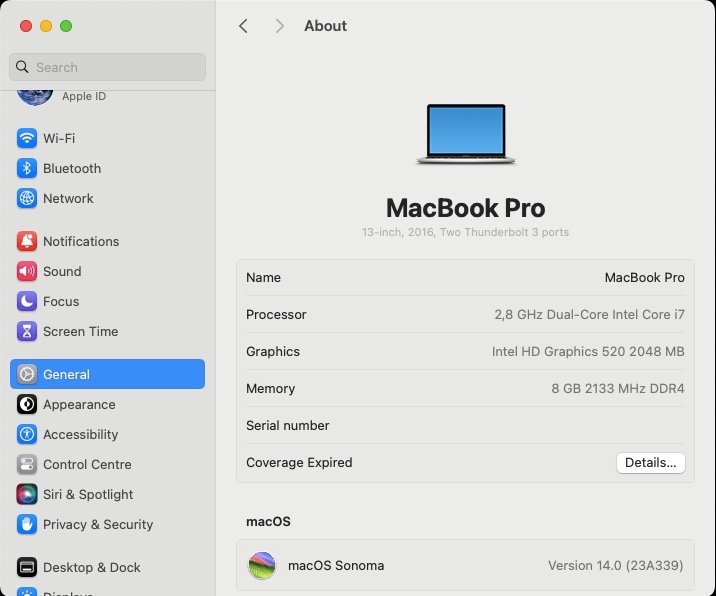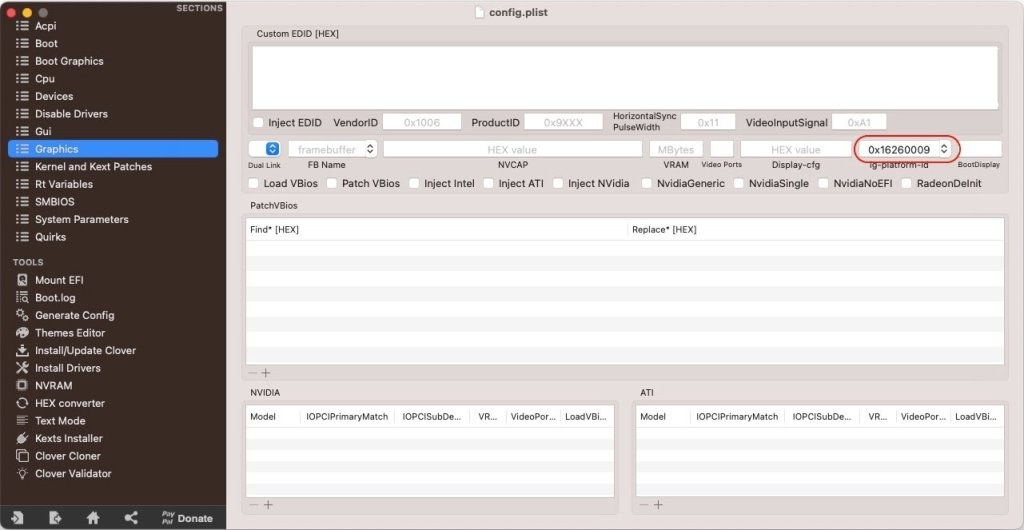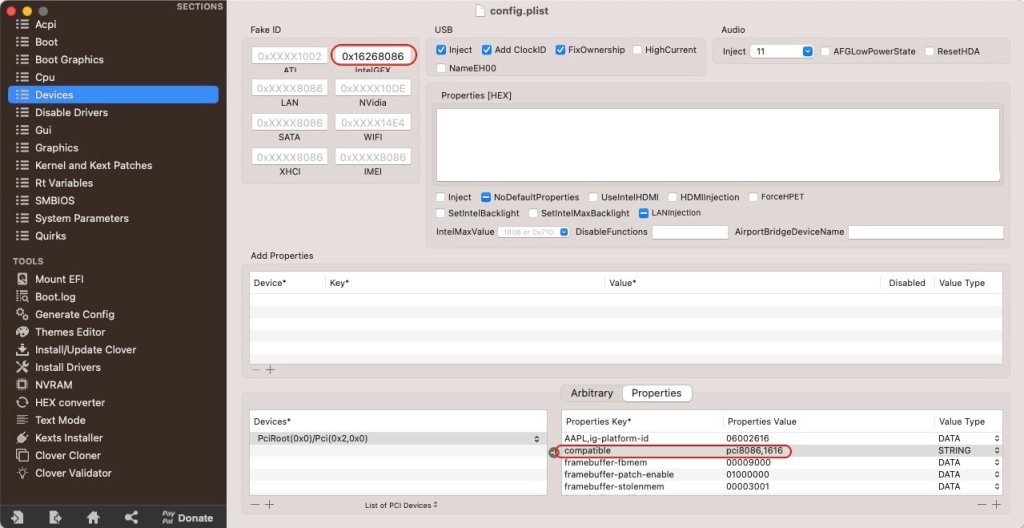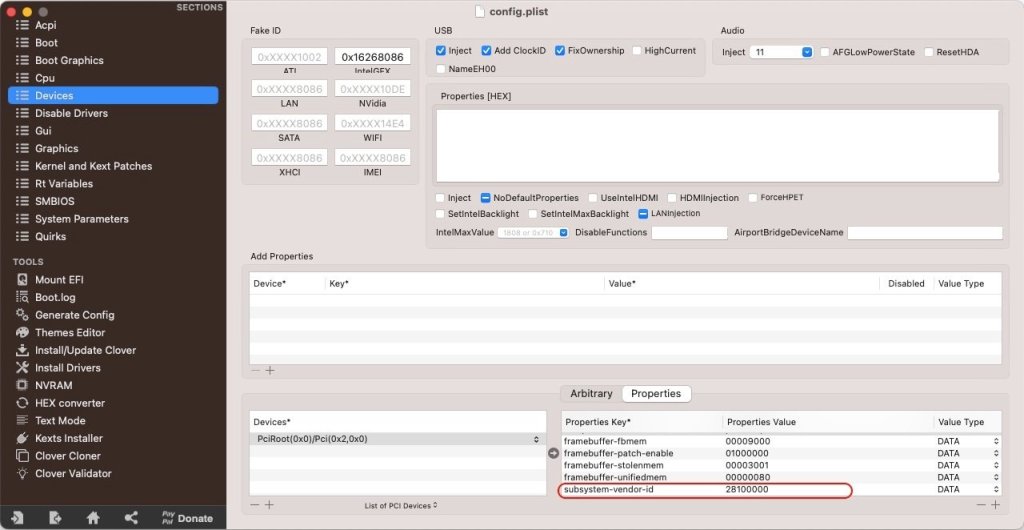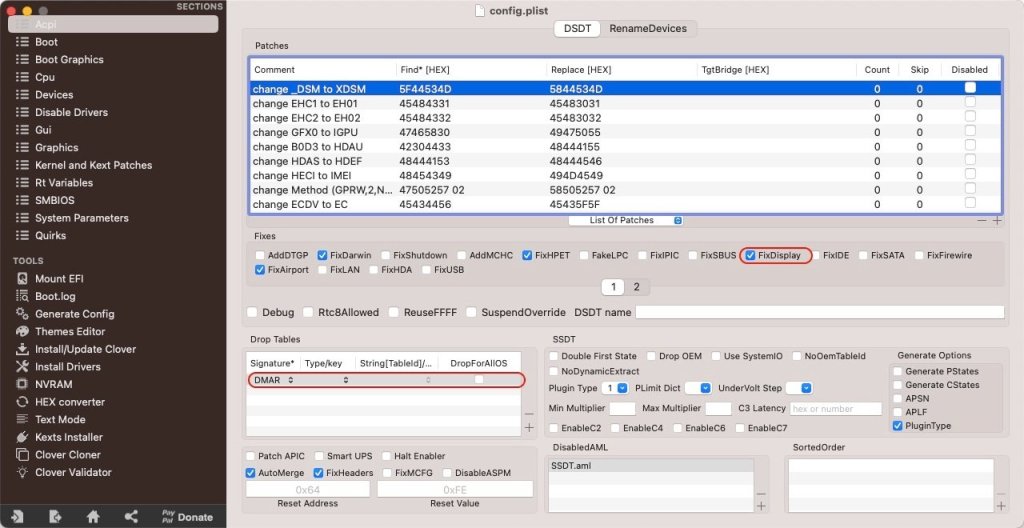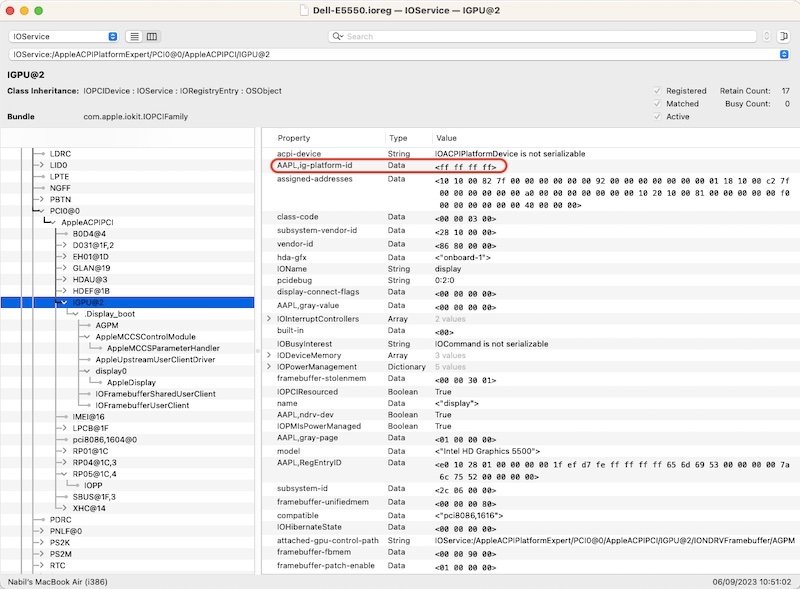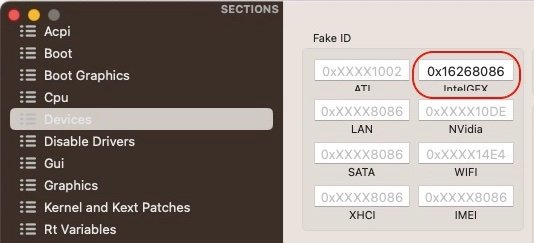-
Posts
9905 -
Joined
-
Last visited
-
Days Won
548
Content Type
Profiles
Articles, News and Tips
Forums
Everything posted by Hervé
-
Follow the guidance published on the Dortania site. Obviously, you install 1st...
-
No change with regards to Intel wireless cards: ITLWM kexts/app remain required (and always will). You'll just have to update to the new versions that support Sonoma. Afaik, it's still work in progress and last official version posted on the ITLWM repo goes back to May. 2023, i.e. before 1st Sonoma beta was even published. Check the issues page where you'll find beta versions for Sonoma: https://github.com/OpenIntelWireless/itlwm/issues
-
Target macOS release: Sonoma 14.x This is a Clover-based installation using the well-known/well documented vanilla method detailed below: Working: full QE/CI with HD520 graphics (with KBL layout 0x59160000, KBL faked id 0x5916, MBP15,2 SMBIOS and Whatevergreen kext v1.6.6 or later) HDMI output OOB but built-in LCD goes off on 1st cable connection. With WEG boot arg igfxonln=1, LCD picture is recovered after closing then re-opening the LID and HDMI is on at 1st boot & after wake mDP output OOB touchscreen with USB HID fix (patch of IOHIDFamily to fake single-user mode) due to Apple dropping support for old USB hardware full audio, including jack microphone input and headset output (with AppleALC kext & layout-id 11) HDMI audio (with KBL con1 connector-type patch) built-in Gigabit Ethernet (with IntelMausiEthernet kext) full CPU power management, including Turbo boost to 3.4GHz (with PlugIn type settings) sleep: Ok through Apple menu->Sleep, lid closure, power button, Fn-Insert and energy savings settings with hibernation mode set to 0 (sleep to RAM) and /var/vm/sleepimage file deleted. wake: Ok through lid opening and power button wireless & bluetooth with any compatible card/USB dongle (see footer note) battery management and monitoring (with ACPIBatteryManager kext) SD card reader (with 1Revenger1's RealtekCardReader kext) integrated webcam OOB keyboard backlight control OOB (for backlit models) audio volume control through Fn-F1/Fn-F2/Fn-F3 brightness control through Fn-F11/Fn-F12 touchpad basic features, incl. buttons (with Rehabman's VoodooPS2Controller kext) but not recognised in PrefPane USB3.0 ports (with Hackintool's generated USBPorts kext) Not Working: N/A Not tested: SmartCard reader macOS Sonoma not natively supporting platforms older than Amber Lake/Coffee Lake/UHD6x0, it cannot be natively installed and cannot natively run on the Skylake/HD520 Latitude E7270 as used to be the case for earlier versions of the OS up to Monterey. This can however be easily achieved by implementing the following settings which allow keeping a full vanilla installation without calling on add-on patches that would install older kexts, frameworks or other necessary files: use of Kaby Lake framebuffer 0x59160000 (0x591B0000 may also be used but requires further graphics connectors patching) fake Kaby Lake HD620 iGPU id 0x5916 use Coffee Lake platform SMBIOS MacBookPro15,2 use Whatevergreen v1.6.6/v1.6.7 minimum 1) 14.x USB installer creation Using a USB key of 16GB minimum, create a Sonoma USB installer through the following Terminal command: sudo <path>/Install\ macOS\ Sonoma.app/Contents/Resources/createinstallmedia --volume /Volumes/<USB key> where: <path> = location of Sonoma installation package (eg: /Applications if freshly downloaded) <USB key> = name of formatted USB volume (eg: USB_16GB) The process will take several minutes. Once completed: install Clover bootloader on the USB installer with the following customised settings: Clover for UEFI booting only Install Clover in the ESP UEFI Drivers Recommended drivers FSInject SMCHelper Human Interface Devices (optional) Ps2MouseDxe UsbMouseDxe FileSystem Drivers ApfsDriverLoader Memory fix drivers OpenRuntime Additional Drivers (optional) NvmExpressDxe PartitionDxe Themes (optional) BootLoaderChooser (optional) CloverConfigPlistValidator (optional) Install Clover Preference Pane (optional) you may use Clover version r5157 or later as attached below (version r5148 minimum but no support for legacy wireless cards before r5157) Clover_r5157.pkg.zip once Clover is installed, launch Clover Configurator app and mount the freshly created EFI partition of the USB installer (attached version supports BlockSkywalk kext patch) Clover Configurator.zip add the (unzipped) HFSPlus driver attached below to the EFI/CLOVER/drivers/UEFI folder HFSPlus.efi.zip open this EFI partition and transfer/copy the files & folders from the Latitude E7270 Sonoma Clover pack below to the EFI/CLOVER folder Clover_Pack_E7270_Sonoma.zip Clover_Pack_E7270_Sonoma_#2.zip Clover_Pack_E7270_Sonoma_#3.zip Clover_Pack_E7270_Sonoma_#4.zip 2) 14.x installation boot the Sonoma USB installer at the Clover main menu, select the "Install macOS Sonoma" partition (but don't press [ENTER]) press [SPACE], select -v verbose option in the menu, then choose to boot with the selected options proceed with installation, creating & formatting the target Sonoma installation through Disk Utility as/if required on 1st reboot, boot off the USB installer and select the freshly created "macOS install from <target Sonoma partition>" repeat this until this partition is no longer offered and only the target Sonoma partition is left to boot Reboot the target Sonoma partition via your USB installer 3) Post-installation tuning Once the target Sonoma partition has booted, complete the 1st boot configuration tuning Once at the desktop, install Clover bootloader on the Sonoma partition/disk with the customised settings listed above Once Clover is installed, launch Clover Configurator app and mount the freshly created EFI partition of the Sonoma partition/disk Open this EFI partition and transfer the files & folders from the above Latitude E7270 Sonoma Clover pack to the EFI/Clover folder You may then reboot and verify that Sonoma boots off your disk through Clover For wifi & Bluetooth, you may use any compatible add-on USB dongle. If you opt for a legacy BCM5350, BCM4360 or BCM43602 wireless card, you'll need to apply OCLP root patches and ensure you boot with Clover r5157 or later (or with OpenCore of course) in order to bypass vanilla IOSkywalkFamily kext and inject replacement IOSkywalkFamily+ IO80211FamilyLegacy kexts. The Clover config attached to the revised bootpack available above already contains the enabled BlockSkywalk kext patch to that effect and the replacement kexts to inject are provided in the kexts folder. Upon launching the OCLP patcher, you should be immediately asked to apply the relevant wireless root patches. See this thread for full details of the process. Edit: 17 Jan 2024 Replaced older Clover version r5153 with version r5157 that supports BlockSkywalk kext patch (required to support legacy wireless cards officially dropped in Sonoma) Revised bootpack with: modified SSDT-GPRW patched ACPI table to fix intermittent loss of Bluetooth on wake. modified Clover config to enable BlockSkywalk kext patch and add -amfi_get_out_of_my_way=1 boot arg added replacement IOSkywalkFamily + older IO80211FamilyLegacy kexts to kexts/Other folder for injection (required to support legacy wireless cards officially dropped in Sonoma) Edit: 10 Mar 2024 Revised bootpack #3 with new versions for wireless kexts required for Sonoma 14.4. Edit: 6 Apr 2024 Revised bootpack #4 with cleanup of SSDT tables.
-
Released Sep 26th, 2023 as announced. Version 14.0, build 23A344 (same as RC2 published Sep 21st). Sonoma drops official support for Kaby Lake platforms that remained supported in Ventura, Apple raising minimal requirements to Amber Lake and Coffee Lake platforms (with the exception of iMacPro1,1 as in Ventura). However, support for Kaby Lake graphics remain provided with all KBL kexts still present, this in order to ensure support for Amber Lake MacBookAir8,1. By extension, this means that graphics support for Skylake iGPUs can also be retained using those same KBL settings as used in Ventura. For other iGPUs, patches are available through OCLP tool to regain graphics acceleration. Officially supported Intel platforms are now limited to : iMac19,x (8th gen. Coffee Lake) iMacPro1,1 (Skylake Xeon) MacBookAir8,1 (8th gen. Amber Lake) MacBookPro15,x (8th gen. Coffee Lake) Macmini8,1 (8th gen Coffee Lake) MacPro7,1 (Cacade Lake) With Sonoma, Apple also dropped official support for what they call "legacy" Broadcom cards that remained supported up to Ventura. These include cards based on Broadcom BCM4350, BCM4360 or BCM43602 chipsets. If Bluetooth remains natively supported on such legacy cards, native Wifi support is now limited to those Apple proprietary Broadcom SOCs that have been fitted to the above Mac models. Support for "legacy" Broadcom cards can however be recovered with specific patching using OpenCore bootloader, kexts blocking and OCLP patches. Officially supported Broadcom SOCs include: BCM4355 (802.11ac): pci14e4,43dc (iMacPro1,1 + MacBookAir8,x) BCM4364 (802.11ac): pci14e4,4464 (Mac mini8,1 + MacBookPro15,x + MacBookPro16,x + iMac19,x + iMac20,x + MacPro7,1) BCM4377b (802.11ac): pci14e4,4488 (MacBookAir9,1) BCM4378 (802.11ax): Apple Silicon Mac models BCM4387 (802.11ax): Apple Silicon Mac models BCM4388 (802.11ax): Apple Silicon Mac models NB: macOS Big Sur is now officially unsupported. View full article
-

[Solved] Dell Precision 7530: HDMI Port issue
Hervé replied to Muhammad Kamel's topic in Precision x000 Series
I had a quick look at your config file, this being all that you posted. I am quite surprised by the amount of SSDT tables you inject, especially those labelled "xxx7080MT" but that's probably nothing todo with loss of HDMI output. Looking at the graphics properties you inject, i.e.: I can't help wondering why you'd inject properties to patch connector con1 (the usually physical port for HDMI) but disable such patching (framebuffer-con1-enable set to 0). Also, you appear to patch the flags of all connectors. To what purpose? As a reminder, default properties of CFL framebuffer 0x3EA50009 are (C.f. Whatevergreen user manual) : ID: 3EA50009, STOLEN: 57 MB, FBMEM: 0 bytes, VRAM: 1536 MB, Flags: 0x00830B0A TOTAL STOLEN: 58 MB, TOTAL CURSOR: 1 MB (1572864 bytes), MAX STOLEN: 172 MB, MAX OVERALL: 173 MB (181940224 bytes) Model name: Intel HD Graphics CFL CRB Camellia: CamelliaV3 (3), Freq: 0 Hz, FreqMax: 0 Hz Mobile: 1, PipeCount: 3, PortCount: 3, FBMemoryCount: 3 [0] busId: 0x00, pipe: 8, type: 0x00000002, flags: 0x00000098 - ConnectorLVDS [1] busId: 0x05, pipe: 9, type: 0x00000400, flags: 0x000001C7 - ConnectorDP [2] busId: 0x04, pipe: 10, type: 0x00000400, flags: 0x000001C7 - ConnectorDP 00000800 02000000 98000000 01050900 00040000 C7010000 02040A00 00040000 C7010000 If changing the connectors' flags is required than you would obviously need to enable such patching, failing what, the default settings are applied. -

Dell Inspiron 3880: No sound, no VGA output, no sleep
Hervé replied to VOLTAGE's topic in Dell Desktops
Post the hardware specs... -
Today (end 2023), there probably is very limited interest in running such old and unsupported versions of macOS... Sierra -> 2016-2019 High Sierra -> 2017-2020 Mojave -> 2018-2021
-
I think it's time you stop. Skylake has no support since Ventura. Hence why we fake KBL graphics for SKL iGPUs.
-
Headless FBs have no output ports by definition so, no, you can't use them. At some point, I think I saw an EDID injection in your IOReg. Is it something you extracted from, say, Windows on your own laptop or was it a value you collected somewhere?
-
Try alternative KBL FBs like 0x591B0000 then.
-
Injecting value 16590000 for a KBL framebuffer is as useful as injecting value 12345678. It's invalid so will not get you anywhere. The list of valid KBL framebuffers is available in the WEG manual here. Reminder: Hexadecimal value 0x12345678 is injected as DATA value 78563412 in a bootloader's config.
-
Released September 12th, 2023. Build 23A339. Smooth and straightforward update using the same usual principles applied before.
-
No, you still get it wrong! You inject AAPL,ig-platform-id with hexadecimal value 16590000 when it should be 00001659. This is getting ridiculous not to say tiring when you were provided with all the correct settings on p1 all those weeks ago. It would also appear that you inject: framebuffer-stolenmem with hexadecimal value 26000000 when it should be 00003001 (or no injection if DVMT set to 64MB or above) framebuffer-fbmem with hexadecimal value 00000000 when it should be 00009000 (or no injection if DVMT set to 64MB or above) see here for details and eventual further adjustments In addition, make sure you boot with: latest version of Whatevergreen kext relevant lilu beta boot args (-lilubetaall or -lilubeta -wegbeta -alcbeta) SMBIOS MBP14,1 + -no_compat_check boot arg -igfxonln=1 if necessary (mostly for HDMI output)
-
Decide which audio layout you want to inject; can't do both, 11 and 28... Re: using/booting multiple versions of macOS, I guess you ignore that Clover supports injecting kexts for multiple OS X/macOS versions... If you look closer in the kexts folder, provided you've properly installed Clover through one of its official installation packages, you should notice sub-folders labelled 10.x or 11/12/13/etc on top of Other. Guess what they're for... You may put in Other folder only those kexts you always want to inject such as Lilu & PlugIns. Of course, and it should be obvious, you can mix use of those version-specific kext folders with the general one. So, to summarise and be crystal clear: kexts/Other -> general purpose folder, kexts that are not version specific kexts/13 -> kexts specific to Ventura kexts/12 -> kexts specific to Monterey kexts/11 -> kexts specific to Big Sur kexts/10.15 -> kexts specific to Catalina etc. all the way down to 10.7 for Lion
-
Looks like graphics are not initialising and system hangs.
-
Looks like you did not understand what I wrote...
-
You cannot "re-route" the output of one connector to another. Connectors correspond to physical video output ports. You can only patch the attributes/settings of connectors, that's all. Why don't try booting your macOS installation, without the framebuffer memory patches, from a USB key ? All you need to do is install/copy your bootloader and existing bootloader's settings on the key, then adjust the config on it to remove stolenmem/fbmem patches.
-
See here where you'll find a link to Firewolf's old blog article on the matter.
-
I'm pretty sure you've done other things that you've not mentioned yet and that would explain your predicament. There's just no way you'd have that kind of trouble with a full vanilla build.
-
In BIOS settings, as usual with all Dell computers. Your posted config is wrong in many respects. Why do you keep adding stuff that are in complete contradiction with each other ??? Proceed as follows: 1) update Clover to latest version 2) adjust your config with latest version of CloverConfigurator app 3) in your config, please remove this: 4) remove this: 5) remove this: 6) remove this: 7) in SMBIOS tab, select a different SMBIOS then MacBookPro12,1 again Then save your Clover config and reboot.
-
I'm talking about the kexts you inject via Clover, of course! Please post actual config files or readable config settings, Base64 code isn't really user friendly or readily readable... This being said, <key>AAPL,ig-platform-id</key> <data> AAAGFg== </data> translates to Broadwell framebuffer 0x16060000 which is a desktop one. I recommend you use the values recommended by WEG, i.e. 0x16260006 preferably or any other mobile value. What's your exact CPU reference/model? You just said "i5"... Injected the iGPU device id does no harm of course but it's probably injecting the same id (natively) carried by your iGPU, which would make the injection useless. I don't believe you need any of these lspcon properties either.
-
Ok, it's not gonna work with that framebuffer id: Strange that this would be a default value when WEG kext is supposed to inject FB 0x1626006 for laptops: https://github.com/acidanthera/WhateverGreen/blob/master/Manual/FAQ.IntelHD.en.md#intel-hd-graphics-5300-6300-broadwell-processors I would double check the config you're using. Search for "ig-platform-id". If you do not find anything, add this to the list of injected graphics properties: AAPL,ig-platform-id 06002616 DATA Maybe you need to check your kexts versions and update to latest should you use old ones. Do post a new copy of your Clover config file and specify which version of Clover you're using. How do you edit your config? With a text editor? a plist editor? CloverConfigurator app?
-
Check your Optimus settings in BIOS; make sure it's enabled. If it's disabled, your laptop will only run on the dGPU. Post a zipped IOReg extract taken from IORegistryExplorer app.
-
I've removed your links to ebay or to DropBox that forced people to have an account. Please avoid such links in the future as per our published rules. I've posted your (basic) Clover stuff: ACPI folder + config file + kexts folder which I have cleaned of the useless stuff. Forget about the GeForce, it's Maxwell so never natively supported and required the nVidia Web Driver which only exists for OS X Yosemite to macOS High Sierra. No such drive since Mojave, no workaround, no solution. Just disable the dGPU to save on battery and run solely on the iGPU. You should have no issue getting graphics acceleration on HD5500, it's been supported for years. You just need to inject the correct properties and properly so... So, remove this from your config: and, instead, inject this: See here.


